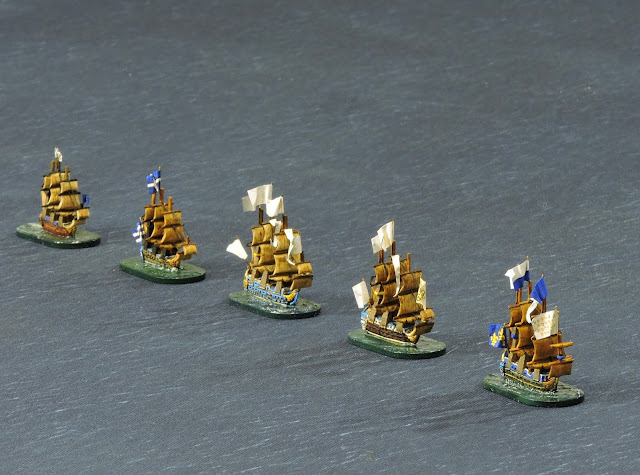Back with the climactic conclusion to the Battle of the Texel...
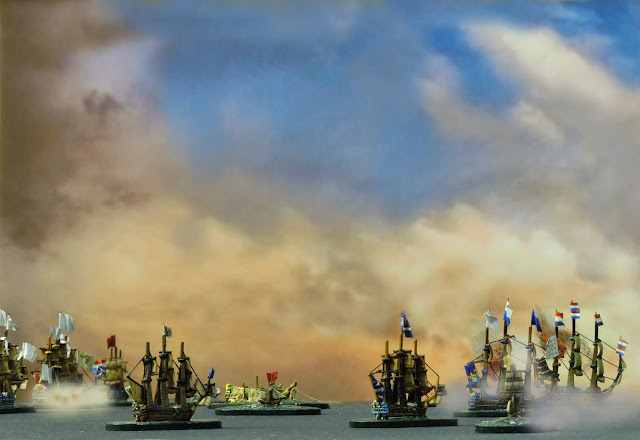 |
| Tonnant (far left) stern rakes Vrijheid (far right) igniting a magazine. Royal Therese is already on fire(right foreground). |
Turn 9 A breath of fresh air
The wind had moved to a light northerly and ships were
permitted only to move at half speed to simulate their emergence from the torpor
of a flat sea. The most alarming situation for the Dutch was that van Nes now
commanding the 2nd rate Vrijheid was extremely isolated from the
remainder of the Dutch fleet. Despite his squadron attempting to make sail to
support, he was on his own with numerous large and dangerous opponents around.
Rising to the challenge he manoeuvred his ship to shoot at the ponderous Royal
Therese.
Vrijheid’s broadside thudded into the French flagship and ignited her forward magazine causing a considerable explosion and fire. Even before the cheering had died down Vrijheid was rocked by a stern rake from Tonnant from some considerable distance. The same fate befell van Nes’ ship as had just been inflicted upon d’Estrees. A magazine ignited throwing the ship into great disorder.
 |
| Duelling ships Vrijheid and Royal Therese both have magazine explosions at the same time. |
Vrijheid’s broadside thudded into the French flagship and ignited her forward magazine causing a considerable explosion and fire. Even before the cheering had died down Vrijheid was rocked by a stern rake from Tonnant from some considerable distance. The same fate befell van Nes’ ship as had just been inflicted upon d’Estrees. A magazine ignited throwing the ship into great disorder.
The hour or so of drifting had brought vessels together by
circumstance. Spiegel getting underway and with loaded guns hit Royal Charles
several times. Unfortunately, the late Prince Rupert’s flagship was also loaded
and loosed a thumping salvo back. This took away Spiegel’s mainmast, part of her
mizzen and the bowsprit leaving her at the mercy of passing English ships.
All vessels apart from those Dutch ships racing to rescue
van Nes now appeared to be converging on the central area of the battle.
 |
| Chaos as the fleets get underway with the return of the wind |
Turn 10 They think it’s all over..
Spiegel’s agony continued as Royal Charles kept on a
parallel course, reloaded and delivered a further crushing broadside to which
the shell-shocked Dutch crew had no answer. Spiegel began to burn preoccupying
her surviving complement.
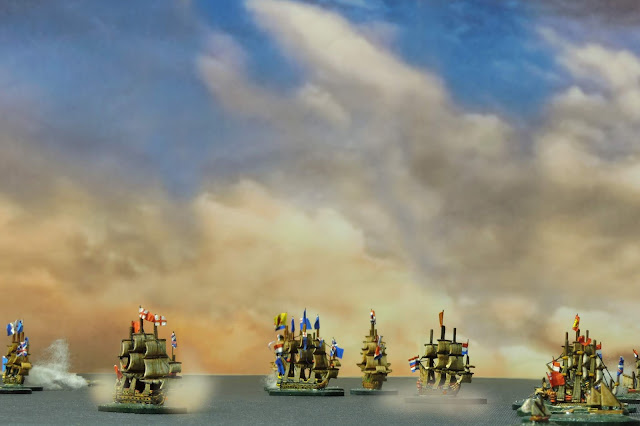 |
| Many things: Royal Charles thumps Spiegel and at centre, Prince outmanoeuvres DZP pouring shot into her. |
Spragge’s undamaged and potent flagship Prince craftily out-sailed
the legend de Ruyter and cut across his bow from the starboard side loosing a
close range broadside on the Dutch flagship to which it was unable to respond.
The low aimed shots caused considerable damage below the waterline and De Zeven
Provinciën
slowed down. Exactly the same manoeuvre was performed with even greater effect
by Cambridge on Voorsichtigheid only a couple of hundred yards distant. This double blow signalled that the end might
be near to my mind anyway.
A total of fifteen ships fired this turn and three of those
concentrated fire on van Nes in the Vrijheid. The French trio Maure, Oriflamme and
Royal Therese relentlessly pounded the Dutch ship and, in the firestorm, a
luckless van Nes met his end together with scores of his brave sailors. On
seeing their beloved admiral fall, the crew struck and surrendered.
Intense close-range duels were taking place everywhere. The
wily captain of Caleb stern raked Reine and highlighting an obvious procedural
flaw in French ship management, set her on fire. The as yet uncommitted Maagd
van Dordrecht wove between the battling ships and stern raked Warspite at close
range causing terrible destruction. Frustrated by his inability to get to grips
with Spragge’s flagship off his starboard bow de Ruyter vent his frustration by
opening up with his port-side guns the 4th rate Princess setting her
on fire.
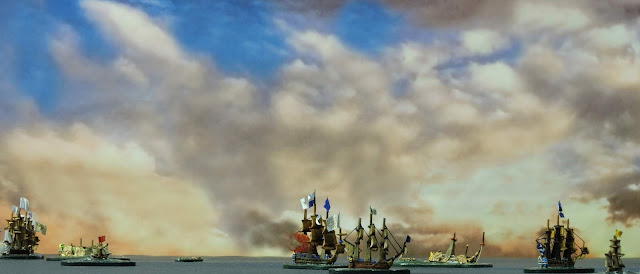 |
| The burning Royal Therese finishes Vrijheid and kills van Nes. |
Dismayed by the loss of their beloved leader the remains of
van Nes’ squadron swarmed around the wounded French flagship Royal Therese
which continued to burn. Many Dutch shots found their mark and it was clear d’Estrees
was in dire straits.
I was prepared to call time on the game at this point but
for some reason felt there was one more turn in it. When you’re in charge,
anything goes so, on to the ultimate round of battle and the result.
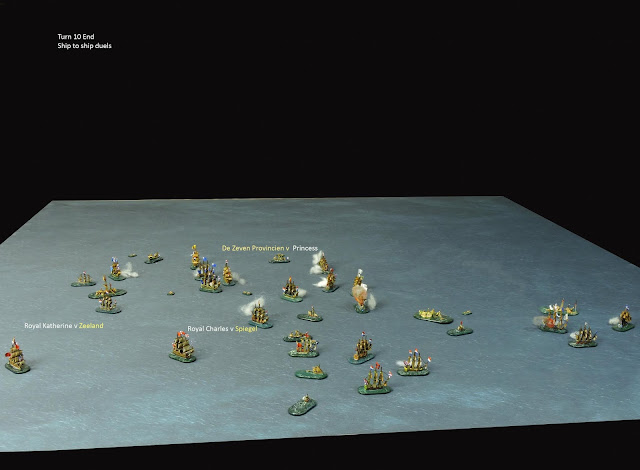 |
| Many ship to ship duels and much other firing during turn 10 |
Turn 11 The last cast of the dice
The loss of three units compelled a squadron morale check
for van Nes ships. This they passed with an unmodified top score! My decision
to carry on was justified. The wind changed once more to the original direction
of north east and picked up strength creating some challenging conditions for
the battered combatants.
It was clear to de Ruyter that a war of attrition would end in
defeat at the muzzles of the heavier and more numerous Allied guns. A battle of
manoeuvre was also out as both the remaining Dutch 2nd rates were
heavily damaged and taking on water. The only option left was the one the enemy
might least expect. De Ruyter signalled for his own ship and Voorsichtigheid to
grapple and board! Admiral de Liefde aboard Voorsichtigheid came alongside and
grappled Cambridge whilst de Ruyter’s own flagship grappled and boarded the
mighty Prince.
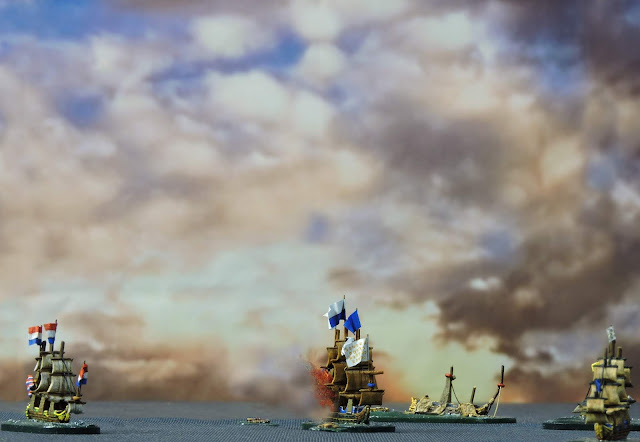 |
| The canny Caleb receives the surrender of Admiral d'Estrees and his burning flagship. |
Royal Therese was burning fiercely and taking on water
forcing d’Estrees to abandon ship and surrender his sword to the gallant
captain of Caleb. The other French 1st rate Reine continued to burn
as Maagd van Dordrecht hit her repeatedly along her port side.
In this climactic turn the as yet undamaged 5th
rate Zeeland cruised past and fired at the wounded Royal Katherine limping slowly
westward attempting to remove herself from the battle. Alas this was somewhat like
a wasp stinging a rhino with toothache. The wounded English ship which had
taken plenty of time to reload fired a broadside of such power that the lightly
built frigate exploded leaving her almost destroyed to the waterline but just
afloat.
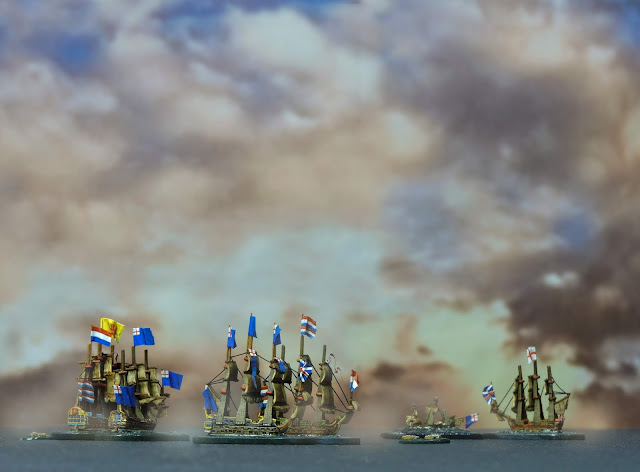 |
| Battle of the giants. Voorsichtigheid boards Cambridge and DZP locks with Prince at the climax. |
And so, back to the battle of the admirals. The veteran
Dutch crews had no difficulty in grappling their opponents. Each ship replete
with seasoned marines gave a throaty hurrah and boarded the two English ships.
Cambridge (70) and Prince (100) were the least damaged ships of all in the Anglo-
French fleet. Spragge’s flagship also had a full complement of soldiers and the
gallant Dutch attack was swiftly repulsed. The same story occurred as de Liefde’s
men scrambled onto the decks of Cambridge. Although this ship did not have
soldiers aboard, the crew fought like lions throwing the Dutch back.
De Ruyter, veteran warrior at sea knew exactly what to do –
He signalled disengage and the Dutch ships broke off heading for their anchorage
off the south coats of Texel island.
The battle was over.
A clear victory for Spragge? Let’s see.
Outcome
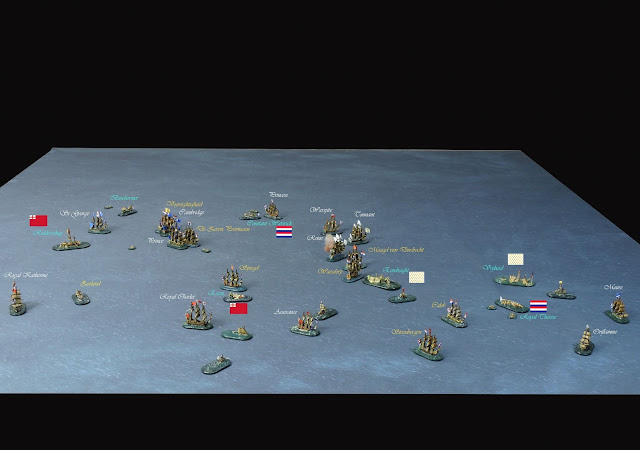 |
| End of Turn 11. The carnage ends as the two flagships disengage centre left. |
A clear victory for Spragge? Let’s see.
Outcome
My first thought was that this was a resounding victory for
the Anglo-French. The Dutch had lost Eendraght (72) and Vrijheid (80),
Ridderschap (65) and Essen (50), all captured. Beschermer (50) and and Zeeland (40)
were barely afloat. De Zeven Provinciën, Voorsichtigheid and Spiegel were
all badly damaged and all fire ships had been expended. In addition, the celebrated
hero Admiral van Nes was dead. Surely, a disaster at sea.
Then, I had a look at the Anglo-French fleet. Admittedly
only two ships had been captured; Constant Warwick (42) and d’Estrees flagship
Royal Therese (100). Royal Katherine, Royal Charles, St George, Warspite,
Princess, Assurance, Reine, Tonnant, Oriflamme and Maure had all sustained
significant damage with a couple barely afloat. All but one fire ship had been
burned. Perhaps the losses of greatest significance were the capture of Admiral
d’Estrees and the death of the King’s uncle, the legendary Prince Ruprecht.
 |
| Prince Rupert sails towards his destiny. |
Dutch points lost were 1,695 from ship damage working out as
65.8% when 100 points for the death of van Nes is added this make a total of
1,795. Ridderschap had also lost two captains killed.
Anglo-French losses amounted to 1,461 from ship damage
working out as 56.7% meaning a differential of less than 10% - a marginal
victory if at all and more likely to be classed as a draw.
Factor in 100 points for the captured d’Estrees and a
further 200 for the loss of Admiral of the Fleet Prince Rupert and total
Anglo-French losses amounted to 1,761. An incredibly tight differential in
points of 34 translating to less than 1.5%.
The Dutch survivors limped into their anchorage at Den
Helder no more than five miles distant. The battered enemy fleet, in no
condition to maintain station off the Dutch coast, out of powder and shot,
hundreds of men down as well as two of their most senior officers faced a parlous
trip home to the Thames and Dunkerque.
The result seemed curiously similar to the outcome of many Dutch Wars naval battles with both fleets suffering terrible damage. Who won?
You may decide.

